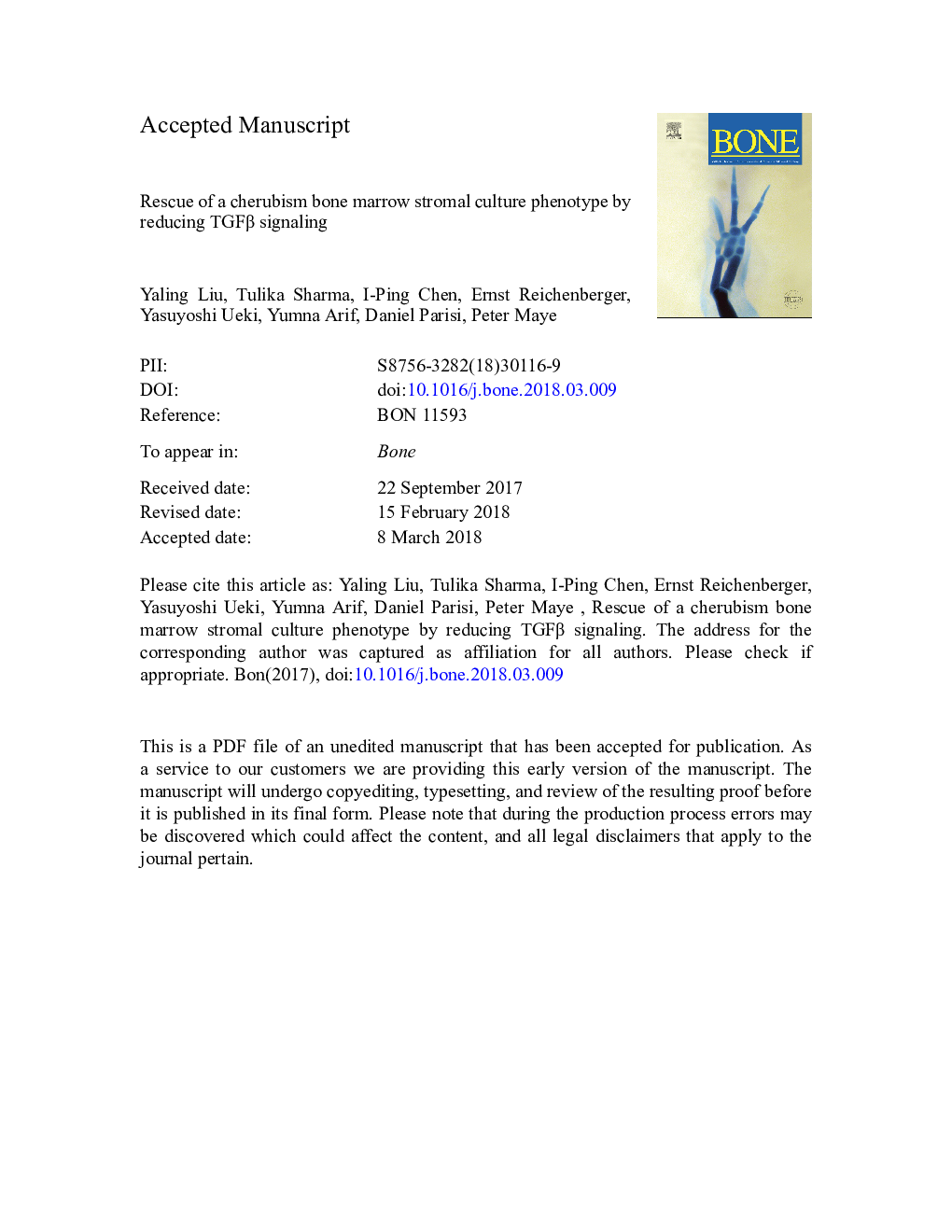| کد مقاله | کد نشریه | سال انتشار | مقاله انگلیسی | نسخه تمام متن |
|---|---|---|---|---|
| 8624898 | 1568108 | 2018 | 23 صفحه PDF | دانلود رایگان |
عنوان انگلیسی مقاله ISI
Rescue of a cherubism bone marrow stromal culture phenotype by reducing TGFβ signaling
دانلود مقاله + سفارش ترجمه
دانلود مقاله ISI انگلیسی
رایگان برای ایرانیان
کلمات کلیدی
موضوعات مرتبط
علوم زیستی و بیوفناوری
بیوشیمی، ژنتیک و زیست شناسی مولکولی
زیست شناسی تکاملی
پیش نمایش صفحه اول مقاله

چکیده انگلیسی
We utilized a bone marrow stromal culture system to investigate changes in TGFβ signaling in a mouse model for cherubism (Sh3bp2KI/KI). Interestingly, bone marrow cultures derived from cherubism mice not only displayed impaired osteoblast differentiation, but also had spontaneous osteoclast formation. PAI1, a target gene of TGFβ signaling, was elevated 2-fold in cherubism CD11bâ,CD45â cells compared to wild type cells, while the expression of BAMBI, an inhibitor of TGFβ signaling, was down-regulated. We also discovered that treatment of cherubism cultures with antagonists of the TGFβ signaling pathway could largely rescue osteoblast differentiation and markedly reduce spontaneous osteoclast formation. Treatment with the type I TGFβ receptor small molecule inhibitor SB505124 increased osteoblast reporter gene Col1a1-2.3 expression 24-fold and increased the expression of osteoblast gene markers Osterix (Sp7) 25-fold, Bone Sialoprotein (BSP) 7-fold, Osteocalcin (Bglap1) 100-fold, and Dentin Matrix Protein 1 (DMP1) 35-fold. In contrast, SB505124 treatment resulted in a significant reductions in osteoclast number and size. Gene expression analyses for RANKL, a positive regulator of osteoclast formation was 2.5-fold higher in osteoblast cultures derived from Sh3bp2KI/KI mice compared to wild type cultures, whereas OPG, an inhibitor of RANKL was 5-fold lower. However, SB505124 treatment reduced RANKL almost back down to wild type levels, while increasing OPG expression. Our studies also implicate a role for TGFβ ligands in the etiology of cherubism. Blocking of TGFβ ligands with the monoclonal antibody 1D11 increased Col1a1-2.3 reporter expression 4-fold and 13-fold in cultures derived from Sh3bp2KI/+ and Sh3bp2KI/KI mice, respectively. Serum levels of latent TGFβ1 were also 2-fold higher in SH3BP2KI/KI mice compared to wild type littermates. Taken together, these studies provide evidence that elevated levels of TGFβ signaling may contribute to the disease phenotype of cherubism and a reduction in pathway activity may be an effective therapeutic approach to treat this rare disease.
ناشر
Database: Elsevier - ScienceDirect (ساینس دایرکت)
Journal: Bone - Volume 111, June 2018, Pages 28-35
Journal: Bone - Volume 111, June 2018, Pages 28-35
نویسندگان
Yaling Liu, Tulika Sharma, I-Ping Chen, Ernst Reichenberger, Yasuyoshi Ueki, Yumna Arif, Daniel Parisi, Peter Maye,